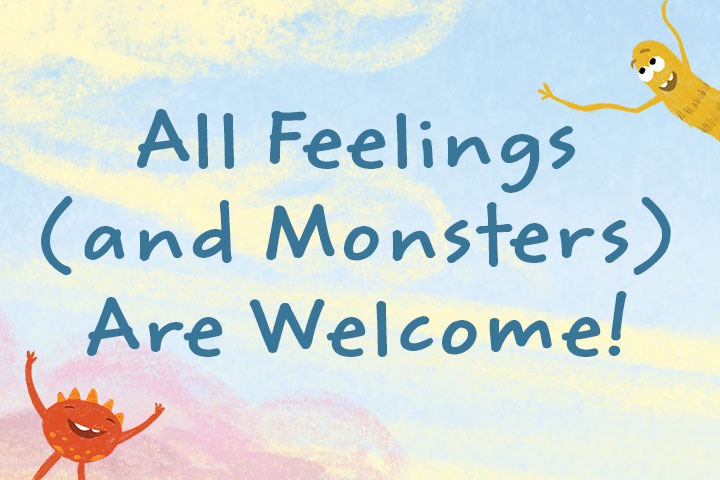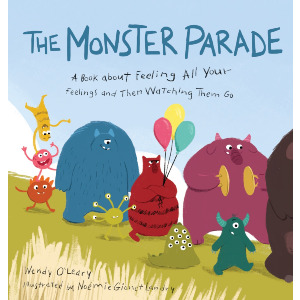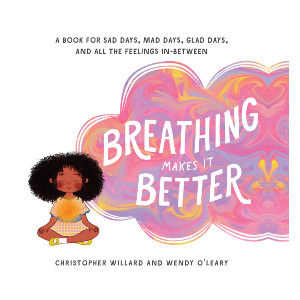By Wendy O'Leary, author of The Monster Parade
At a book signing for Breathing Makes It Better, a woman told me her story about trying to use breathing strategies with her children. She said, “My children were fighting and I pointed to your book and said to them, ‘Hey, Breathing Makes It Better!’” You may not be surprised to learn that her approach did not miraculously fix the issue. In fact, one child responded, “No it doesn’t!”
Now, do not get me wrong, I love Breathing Makes It Better and the messages and teachings in the book. And in no way does that book encourage invalidating, pushing away, or suppressing emotions. In fact, the children in the story always acknowledge their feelings and how their emotions show up in their bodies before working with them skillfully, using breath and imagery. Not to mention the references to the fact that we all have a range of feelings, that emotions are totally normal, and that they come and go.
The nuanced difference is that we are teaching the breathing practice not to “get rid of” feelings, but to change how the child is relating to them. A nuance she had missed by not yet having read the book.
Unpleasant feelings come and go for everyone and are simply a part of being human.
There is a bit of an art and some subtlety required here which can be challenging in a society where we like things to be black and white—we can get uncomfortable around the gray areas. Many would prefer to keep it simple and hold the view that some feelings are bad and we should breathe and try to get rid of them, and some are good which means everything is great. And yet, it is crucial not to over-simplify working effectively with emotions, especially when teaching and sharing practices with children.
Yes, calming practices highlighted in so many teachings and books like Breathing Makes It Better are essential in supporting children as they learn to regulate their systems and not get carried away by their emotions, but wait. . . there is more!
Making an emotion “bad” only pushes it underground where it can get into mischief.
Unpleasant feelings come and go for everyone and are simply a part of being human. Imagine the emotional freedom that is possible if we didn’t make this a problem! We need to be cautious about demonizing any feelings. Making an emotion “bad” only pushes it underground where it can get into mischief. What if instead we could be aware and interested in our emotions and learn to relate more effectively to them instead of being pushed around—often unknowingly—by their energy?
The Monster Parade encourages just that, as it delves more deeply into this aspect of working with emotions for children by encouraging a playful and curious relationship to all feelings. This idea came to me when remembering the days of having my own children parade around the house as if they were having different experiences, emotions, or as different creatures. When I started teaching mindfulness to children, I remembered those fun games and turned them into a mindfulness activity. At one point, I had 30 kindergarten children marching around a gym in a parade of angry monsters—a fun and useful activity! And yes, of course I set up some guidelines for a silent parade where the monsters did not touch anyone or anything! The “parade” was followed by conversations about how the body feels when we pretend to be different monsters and have different feelings. We reflected on what monsters appear and disappear throughout our day. We even investigated which ones visit most often and what helps so we don’t jump into the parade with them!
The monsters aren’t in charge, but we need to acknowledge that they are in the parade and let them march on by!
This ability to be interested in all feelings, even ones that are unpleasant, and notice how we are relating to them is at the heart of The Monster Parade. And it is full of practices integrated right into the story so the children, and the grown-ups, can practice along! The verse keeps it light, playful, and fun for little ones with depth of concepts and practices that can be useful for older children, too. This book supports the aspect of mindfulness for children that I describe as “all feelings are welcome, they just don’t have to be in charge.” The monsters aren’t in charge, but we need to acknowledge that they are in the parade and let them march on by!
Get ready, here comes. . . The Monster Parade!
Share
WENDY O’LEARY, MEd, is a mindfulness educator and a certified meditation and yoga teacher with a long-standing personal meditation practice. Wendy’s books are based on her 15-plus years of experience teaching mindfulness and skills for emotional awareness and regulation to children and “their adults.” She is a certified parent educator and an online contributor to Mindful Magazine. She is the co-author of Breathing Makes It Better: A Book for Sad Days, Mad Days, Glad Days, and All the Feelings In-Between (Bala Kids, 2019). To learn more, please visit Wendy’s website.




